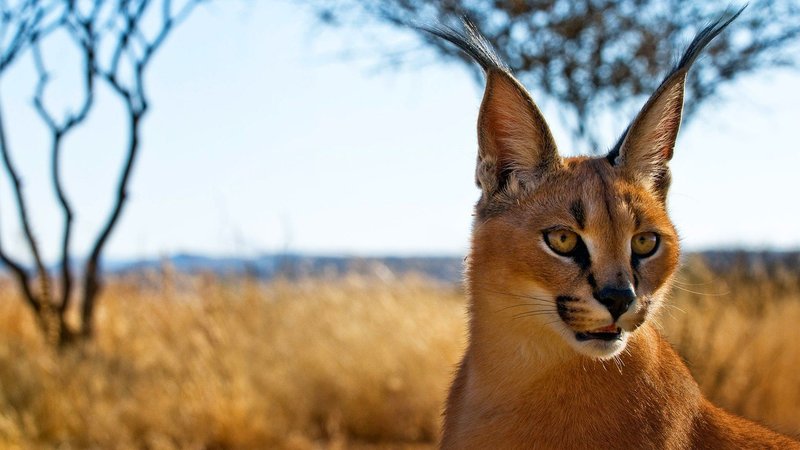
If you’re curious about the caracal and wondering about its relatives, you’re in for a treat. There are quite a few animals that share similar characteristics with the caracal, whether it’s their appearance, habitat, or behavior. In this article, we’ll dive into ten animals that resemble the caracal and explore how to tell them apart. So grab your favorite drink, settle in, and let’s explore the wild world of felines and their lookalikes!
1. African Golden Cat
The African golden cat is a smaller, elusive relative of the caracal found primarily in the rainforests of West and Central Africa. Just like the caracal, it has a rich, golden-brown coat, but there are key differences.
This cat typically weighs between 20 to 35 pounds and has a more streamlined body than the caracal. While the caracal has those iconic tufted ears, the African golden cat has small, rounded ears that blend into its fur. If you spot one, you might notice its distinctive black stripes along its cheeks, which add to its charm.
Habitat plays a big role in their differences too. While caracals thrive in savannas and mountainous areas, the African golden cat prefers dense forests. This preference for cover leads to its more secretive nature, making it less frequently seen than its caracal cousin.
2. Serval
Another feline that shares a striking similarity with the caracal is the serval. This wild cat boasts long legs and a similar coat pattern, but its size and structure differ. Servals are generally taller and leaner, weighing around 20 to 40 pounds.
You might be wondering how to tell them apart. One of the easiest ways is to look at the ears. Servals have larger, more rounded ears compared to the pointed tufted ears of the caracal. Plus, servals have a more pronounced spotted coat, while the caracal’s fur is more uniformly colored.
Both cats share a love for similar habitats, often found in grasslands and wetlands. They are both excellent hunters too, with the serval being known for its impressive jumping abilities to catch birds in flight.
3. Lynx
When comparing the caracal, it’s hard not to mention the lynx. This medium-sized wild cat is known for its tufted ears and a similar build. Lynxes have thick fur, especially in colder climates, which sets them apart visually.
The lynx also has a more robust frame and larger paws, which help them move through snowy terrains effortlessly. Their fur can vary in color, but you’ll often find the lynx sporting a more spotted or striped coat compared to the caracal’s solid look.
While caracals tend to prefer open spaces, lynxes are more adapted to forested areas. They both love to hunt, but their prey differs—lynxes often take down larger game like hares, while caracals are known for their agility in catching birds.
4. Bobcat
Meet the bobcat, another close relative to the caracal. This small cat is native to North America and has a similar shape but is noticeably smaller, weighing between 15 to 30 pounds. Bobcats are known for their distinct “bobbed” tails, which set them apart from the caracal’s long, flowing tail.
While the caracal flaunts its golden tan fur, bobcats typically have a coat that’s more of a mix of browns, grays, and blacks, with distinct spots and stripes. Their facial markings also differ, as bobcats have a more pronounced stripe pattern around their cheeks and eyes.
Habitat-wise, bobcats thrive in a wide range of environments, from forests to deserts. They enjoy a diverse diet, mainly consisting of small mammals and birds, similar to the caracal’s prey choices.
5. Cheetah
The cheetah is another fascinating feline that you might find reminiscent of the caracal, especially due to its agile nature and sleek body. However, cheetahs have a unique appearance, most notably their long legs and distinct black tear markings running from their eyes down to their mouths.
In terms of size, cheetahs are generally larger than caracals, weighing between 77 to 143 pounds. They also have a different hunting style, relying on their incredible speed to chase down prey rather than the stealthy stalking method favored by caracals.
Though they both inhabit similar open landscapes, cheetahs prefer savannas, where they can utilize their speed. Meanwhile, caracals are just as comfortable in rocky terrains and forests.
6. Eurasian Lynx
An intriguing cousin to both the lynx and caracal is the Eurasian lynx. Found across Europe and Siberia, this lynx species is larger and heavier than its American counterpart. They’re incredibly adaptable and can survive in various habitats, from snowy mountains to dense forests.
The distinguishing factor is their size. The Eurasian lynx can weigh up to 66 pounds, making it bulkier than a caracal. The coat of the Eurasian lynx varies from a pale yellow to a reddish-brown, complete with dark spots that blend into the landscape, helping them stay hidden from prey.
While both the caracal and Eurasian lynx feature tufted ears, the Eurasian lynx’s ears are usually longer and more pointed. Their hunting patterns are somewhat similar, but the Eurasian lynx tends to hunt larger prey, including deer, while the caracal focuses on smaller animals.
7. Ocelot
The ocelot is a small wild cat found in South America, and while similar in shape to the caracal, it has a totally different look. Ocelots have a beautiful coat marked with spots and stripes, resembling a small leopard more than a caracal.
They typically weigh between 20 to 40 pounds, placing them in a similar weight range as the caracal. One major difference is their shorter legs and smaller stature, giving them a more compact appearance.
Habitat-wise, ocelots can be found in a variety of environments, from rainforests to scrublands. Their hunting methods are also a bit different, as they tend to be more solitary and rely on stealth to ambush their prey at night.
8. Fishing Cat
The fishing cat might not look much like the caracal at first glance, but it has a similar size and build. Native to wetlands in South and Southeast Asia, fishing cats are a bit unique because of their love for water.
They weigh around 20 to 35 pounds, similar to caracals, but their coat is a short, spotted pattern that helps camouflage them in their marshy habitats. Unlike the caracal’s tufted ears, fishing cats have more rounded ones, which blend in with their heads.
These cats have specialized hunting skills, often catching fish and amphibians, which shows just how adaptable felines can be in different environments. Their love for water sets them apart, making them quite distinctive in the cat family.
9. Sand Cat
The sand cat is a delightful creature that lives in the deserts of Africa and Asia. It’s small, weighing only around 3.5 to 7.5 pounds, which is much lighter than the caracal. Their sandy-colored coat helps them blend perfectly into their arid surroundings.
You might notice that sand cats have short ears unlike the caracal’s striking tufts and a more compact face. Even though they are smaller, sand cats are tough little hunters, preying primarily on rodents and insects, and they are excellent diggers to find food underground.
While both cats are adapted to their environments, their adaptations are quite different. The sand cat’s ability to thrive in extreme desert conditions sets it apart from the caracal’s preference for more varied habitats.
10. Pallas’s Cat
Last but not least, the Pallas’s cat, also known as the manul, is an adorable feline found in the grasslands and mountain steppes of Central Asia. It’s quite small, weighing only about 5 to 9 pounds. With its round face, short tail, and thick fur, it looks quite different from the sleek caracal.
Pallas’s cats have a puffed-up appearance, with a coat that can vary from gray to light brown, covered in spots that help them camouflage in rocky landscapes. While the caracal is known for its agility and speed, the Pallas’s cat is quite the opposite—more of a stealthy, slow hunter that relies on its excellent eyesight to catch prey.
Their habitats differ greatly as well, with Pallas’s cats preferring rugged, cold climates, whereas caracals are versatile and can be found in various environments.
Wrapping It Up
It’s fascinating to see how many animals share traits with the caracal, whether it’s physical characteristics, hunting skills, or habitat preferences. From the sleek serval to the elusive African golden cat, each of these felines has its own unique story and environment that shapes how they live.
So, whether you’re a fan of big cats or just fascinated by the incredible diversity within the feline family, there’s so much to appreciate and learn about these animals. Next time you think of the caracal, don’t forget about its relatives—each one contributes to the rich tapestry of our world’s wildlife.

